
The Homeland Security Department last month released what they said was nontoxic gas into New York’s Grand Central Station to trace how chemicals might flow through the terminal in a terrorist attack. We speak with biological and chemical terrorism expert Leonard Cole, who asks what this “nontoxic gas” actually was. He wrote a book about how–in the 1950s and 1960s, U.S. government scientists ran a series of tests to determine how easy it would be to expose large numbers of people to a lethal bacteria. [includes rush transcript]
In the aftermath of the London bombings, the U.S. Government raised the terrorist threat level to Orange, or “High.” The alert was particularly applied to the nation’s trains and subway systems. Although far less money has been spent on security measures for public transportation than for the airline industry, experts say subways and trains may be particularly vulnerable to chemical and biological attacks. Late last month, the Homeland Security Department released what they said was nontoxic gas into New York’s Grand Central Station to trace how chemicals might flow through the terminal in a terrorist attack.
But some government simulations of chemical and biological attacks in the past have been somewhat different.
In the 1950s and sixties, scientists from the Fort Detrick biological weapons program ran a series of tests to determine how easy it would be to expose large numbers of people to a lethal bacteria. Containers of nontoxic bacteria were planted in the New York subway, bacteria was secretly pumped into the Pentagon ventilation system and clouds of bacteria were released in San Francisco. And germs that were meant to sicken but not kill humans were tested on conscientious objectors in the military.
- Leonard Cole, an Adjunct Professor of Political Science at Rutgers-Newark in New Jersey. An expert in biological and chemical terrorism, Cole is also the author of “The Eleventh Plague, The Politics of Chemical and Biological Warfare,” and “The Anthrax Letters: A Medical Detective Story.”
Transcript
AMY GOODMAN: To talk about all this, we are joined by Leonard Cole, who has written a book about the subject. An expert in biological and chemical terrorism, his book is called, The Eleventh Plague: The Politics of Chemical and Biological Warfare. Welcome to Democracy Now!
LEONARD COLE: Hi.
AMY GOODMAN: It’s great to have you with us. In a few minutes, I want to go to your next book, which is something I think a lot of people have forgotten about, and that is The Anthrax Letters. That’s right. Who did it, we don’t know. But first let’s go to this story.
LEONARD COLE: Sure.
AMY GOODMAN: The Grand Central experiment or the test that was done just a few weeks ago, do you know anything about it?
LEONARD COLE: Only what I saw in the newspaper that was reported just a few days back that a non-toxic gas was flowed through the Central — Grand Central Terminal, and as you said, the purpose was to see what the air flow would be like, so that presumably we could institute some protections and defenses. What I found interesting was that while the newspaper article reported that the gas was non-toxic, that it was invisible, odorless, it did not name the gas, and that would be interesting for to us find out.
AMY GOODMAN: Well, let’s go to something we know more about, and that is a previous experiment in the New York subways. Can you talk about that in as much detail as you know?
LEONARD COLE: Sure.
AMY GOODMAN: When did it happen?
LEONARD COLE: The test in the subways was in 1966, and it was part of an experimental program that lasted 20 years, beginning in 1949, ending only in 1969. During that period, the army acknowledged that some 239 vulnerability tests had been conducted in which large numbers of people, of human citizens of this country, were exposed. They emphasized that the materials that were used to simulate anthrax and other deadly organisms were harmless. But in my research, and in the work that was published in the book, it was very clear that some of the materials were not totally harmless, that when you expose a million or 2 or 3 million people to relatively harmless materials, you still have a certain segment of the population that would be at risk.
AMY GOODMAN: So, talk about specifically what happened in the subway.
LEONARD COLE: Sure.
AMY GOODMAN: How many agents went underground?
LEONARD COLE: When you use the word agent, it has a double meaning. Sometimes it means human beings who are actually conducting the experiments, sometimes — and the army refers to them, the test, the people actually refer to the organisms as agents that were released. So I’ll try to be careful.
AMY GOODMAN: So how many agents released agents?
LEONARD COLE: Well, we don’t know how many individuals went down to release. There were probably somewhere, my guess is in the order of anywhere from a half dozen to a dozen. More importantly, the number of bacterial agents that were released ranged in the trillions. In fact, the way this was done was kind of bizarre, and yet interesting. A light bulb was filled with some 87 trillion organisms, something called bacillus subtilis. And this bacillus, this bacterium, and is common in nature. And as I said before, most people would not be affected. However some people in immune compromised situation, very old people, babies, they would be more susceptible. Trillions and trillions were released. Light bulbs —
AMY GOODMAN: When you say released, you’re talking light — they’re put into light bulbs?
LEONARD COLE: They were placed in army laboratories in light bulbs and mixed with charcoal. The human agent would carry a paper bag containing some light bulbs filled with bacterium.
AMY GOODMAN: Black light bulbs?
LEONARD COLE: I don’t know what the color of the light bulbs were. But he would walk down during peak traffic hours to various subway platforms. This was during in a six-day period in September of 1966. As the train would be coming into the station, he would take a light bulb out of the bag, drop it onto the tracks, and as the train entered, you would see a whoosh of darkened air, darkened clouds. The darkness came from charcoal that was a mixed with the bacteria, because the bacteria themselves were invisible. There were various detection devices set up around the subway system so one could then estimate how many bacteria had survived, and how many of them had concentrated in various areas. At the end of six days, as reports were written, the ultimate report said that if a — as they said, a pathogenic organism were released, that more than half of the people who were riding the subways could have become deathly ill.
AMY GOODMAN: Do we know about people who got sick?
LEONARD COLE: In the course of research, some years after, when the public first learned about this, and in writing the book, I wrote to the New York City Subway System or the — I guess it was the authority — the Subway Authority and asked for absentee records, people who were not showing up for work, just to see how this was around those dates, and I got a short reply back saying, when I wrote to them — it was in the early 1980s — they said they don’t have records that go back that far.
AMY GOODMAN: Because we do know about what happened in the Bay Area, right, with the release of toxins. Can you talk about that?
LEONARD COLE: Sure. This was perhaps the most dramatic and well-reported incident, which we learned about only decades after it was actually conducted. In 1950, another bacterium, and any doctors or microbiologists will recognize this immediately as not something that you should play around with, it was called serratia marcescens. These bacteria were released from the Bay of San Francisco, a boat was spraying trillions of these bacteria onshore. And this is very interesting, because in San Francisco in 1950, a major hospital, university hospital, Stanford University Hospital was located, and they had never recorded any infections from serratia marcescens. Unbeknown to the doctors or anybody in the hospital, the army released the bacteria. Three days later, a case of the serratia marcescens was discovered in the hospital. A dozen or so occurred in the subsequent months. One of the patients died of serratia infection.
AMY GOODMAN: What does that mean? What happens to the person?
LEONARD COLE: These bacteria colonized his heart valve. The bacteria can infect various organs of the body, particularly with weakened people. Now, a person who was in the hospital who had had surgery emerged, became infected, and he died. And what is fascinating is that when the public first learned about this test, mind you, the test occurred in 1950, there were news reports about the test for the first time in the year 1976 and ’77. The grandson of the — the grandson of the person who died, Edward Nevin, who died, the grandson is named Edward Nevin the third, was reading about this, as he was commuting from his home in Berkeley, California, to his law office in San Francisco.
AMY GOODMAN: So he’s on the BART, and he’s reading about these tests.
LEONARD COLE: Exactly. And he’s reading about it. And then he sees his grandfather’s name mentioned as a person who died from this bacterial infection. And he said, 'Oh, my goodness, that's my grandfather.’ Well, to cut through a couple of years following that, he instituted suit against the government. In 1981, there was a trial. The Nevin family sued the US government for these tests, and for the death of their grandparent, and it — they lost the case, but in the course of the trial, he managed to get tons of material that was exposed for the first time, and the public learned about it, much of which I have reported in my own research and book.
AMY GOODMAN: Professor Cole, do we have reason to be concerned that with heightened fear and concern about a biological attack that these kind of tests to see, for example, air flow, etc., will now continue today?
LEONARD COLE: Oh, I think that there’s no reason to think they won’t continue. I mean, certainly, we have evidence by a news report that they were instituted in Grand Central Terminal. My guess is that that would not be the only location. On the other hand, in fairness, we do have to understand that we want to defend ourselves against the possible release of these materials. The question is how you do it, what the material is that you are using as a test agent. If we use anything like the bacteria that were used in the 50s and 60s, we’re creating risk situations for millions of people.
AMY GOODMAN: We’re talking to Professor Leonard Cole. He teaches political science at Rutgers-Newark. His book is called The Eleventh Plague: The Politics of Biological and Chemical Warfare. You have also written The Anthrax Letters: A Medical Detective Story. We’re talking about terrorist attacks right now. We know about September 11, we certainly know about Madrid, and what happened in London. Everyone was afraid when the anthrax letters targeted the National Enquirer and killed the post office workers, but seems to hardly ever have been raised. President Bush certainly hardly raises this. What do we know about who sent them soon after September 11?
LEONARD COLE: Soon, indeed. The first postmarked letters that were later identified were September 18; exactly one week later, they had been sent out. We don’t know who did it. When I say we, I mean, the public. The FBI has focused on the notion that it was probably a lone disaffected American domestic scientist who had access to these bacteria, highly refined virulent bacteria, dangerous bacteria, access to them in one of the laboratories in the US.
There are a lot of things that have happened in retrospect that sound amazing. For example, it wasn’t until two years ago or three years ago, actually, in the year 2001, that we even had regulations that required scientists who handle these virulent dangerous bacteria to report to the Centers for Disease Control that they have them in stock. But until now, or until that period, people had stocks of terribly dangerous materials in their laboratories, and nobody would necessarily know about them, except they themselves who had them there. And that was perfectly legal. So, at the time that these bacteria were released, there were possibilities for access, getting to these materials by a lot of people. So, we don’t know who did it.
It is — I find it quite interesting that the notion that the bacteria were sent out exactly seven days, the first letters were sent out seven days after September 11, and then a whole bunch of other circumstantial dots, as I suggest, would suggest that maybe there was some, at least, awareness by whoever sent them out about September 11 in advance because to prepare this material, to find out who you want to send these poisoned letters to, to get them out and write the letter, and do it all in six days’ time, while it’s certainly physically possible, but it would be an awful stretch to think that it could be done easily.
AMY GOODMAN: What is the profile the government has of who this person or people are?
LEONARD COLE: Amazingly specific. And I can cut through by saying that the profile that they offered on the website, the FBI put on its site, ultimately closely fits somebody who was actually named in the year 2002 by then Attorney General John Ashcroft, as quote, “a person of interest.” The man’s name is Steven Hatfill. Hatfill has never been charged. And when the press asked the Attorney General, 'Well, is he a suspect?' the Attorney General said, 'No, no. He's just a person of interest.’ No other persons of interest were named, although ostensibly there were dozens who were being looked at. Hatfill, since his being named, lost his job, can’t get a job anyplace and has sued the government for millions of dollars. And his case is still pending.
AMY GOODMAN: Do you think if the person of interest had been a different ethnic background or religious background, that there would have been a great deal more of attention paid, media focusing on this issue?
LEONARD COLE: There was a gentleman of Egyptian extract who worked at Fort Detrick, and he was also investigated. He was never named publicly, but the word got out through, I guess through the gossip mill at Fort Detrick and elsewhere that a man of Arab extract who said that he had been discriminated — suffered discrimination there in any case ultimately was being investigated carefully. There were probably scores of scientists, scores of people who fit the profile, but the only one named, as I say, was Hatfill.
AMY GOODMAN: And what is your conclusion?
LEONARD COLE: I would — my conclusion — I don’t mean to be glib or flip, I would just say that there’s a very good chance that a year from now we will be asking the same question, what is my thought? I don’t know who did it. I would say that all options are open. If the FBI has information more than has been released to the public, I think we ought to be hearing more about it.
AMY GOODMAN: Leonard Cole, I want to thank you for being with us, Adjunct Professor of Political Science at Rutgers, Newark. Author of The Eleventh Plague: The Politics of Biological and Chemical Warfare and his latest book, The Anthrax Letters: A Medical Detective Story.


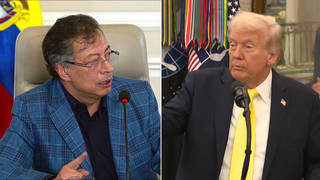
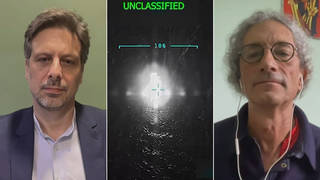
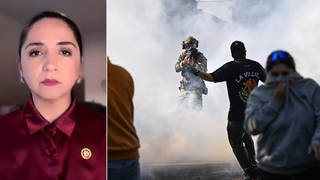





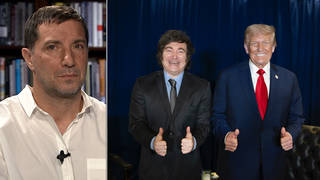
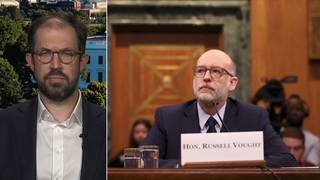
Media Options